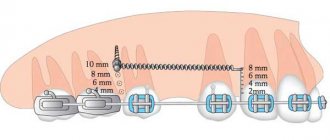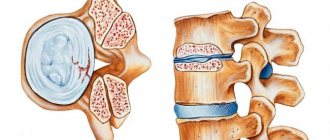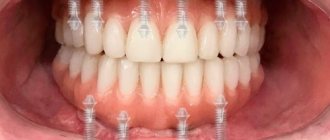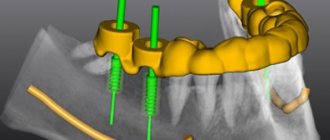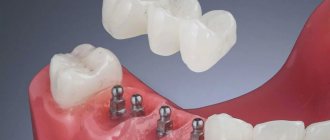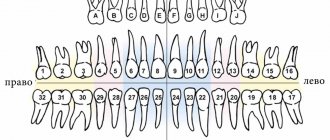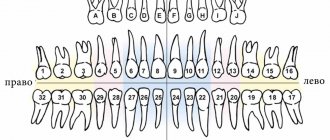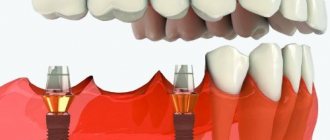Are you planning microimplant orthodontic treatment with the installation of braces? Perhaps you, as a potential patient, are considering microimplants as an alternative to traditional implants that are screwed into the bone? Everything you need to know about microimplants, indications for their use and possible contraindications is in our material. Experts share their independent opinions and reveal facts that are not always discussed in dentistry. Read the material to the end to be aware of all the important nuances.
Indications for the use of microimplants
- Orthodontic treatment. In orthodontics, mini-implants are used as additional support for a brace system. Their installation is required if selective correction of the position of the teeth is required. For example, if one tooth is displaced relative to its axis or has an incorrect position. However, all other teeth do not require correction. Fixing a brace on an adjacent healthy tooth can lead to the risk of it moving. A microimplant allows you to reduce this risk to zero. It is screwed into the gum and serves as a support for the braces system, balancing the pressure. The teeth move along the trajectory planned by the orthodontist. In this case, healthy units are not affected. After treatment is completed, the rod is removed.
- Orthopedic treatment. In orthopedics, microimplants are used as a support for removable dentures. To fix the prosthesis, it is usually necessary to implant 4-6 microimplants, after which the system copes well with the occlusal load. Due to their miniature size, they take root even in the upper jaw with bone atrophy. The microimplant can be loaded immediately after installation, without waiting for complete osseointegration. Compared to classic implantation, this is a less invasive procedure. Therefore, it is suitable as an alternative to conventional dental implantation for certain contraindications. A microimplant can be installed in case of bone atrophy, contraindications to osteoplasty, or complicated clinical picture.
How much do mini implants cost?
Many people are concerned about the cost of mini-implants. As already mentioned, the price of mini-implants is lower than that of classical systems. This is especially true for top-end structures, the installation of which can cost 50 thousand rubles or more. The price of one mini-implant averages 12 – 15 thousand rubles. At the same time, a single installation of a mini-implant is used mainly only in orthodontics: a larger number is required for orthopedic treatment. The price for prosthetics with mini-implants is approximately 90 – 120 thousand rubles. The total amount depends on the manufacturing company, the quality of the orthopedic design, as well as the level of the dental clinic in Moscow where the treatment is carried out.
Contraindications
Microimplants are less traumatic than conventional implants, but their installation has a number of contraindications. Most of them are not absolute. A final decision on the possibility of installing a microimplant will require examination and, possibly, additional treatment. Contraindications include:
- Diabetes mellitus in the stage of decompensation.
- Inflammation in the oral cavity.
- Gum diseases.
- Loose bone tissue.
- Mental illnesses.
- Oncological diseases.
Microimplants should not be placed on patients who smoke. Smoking slows down the healing process, which can cause various complications and reduce the effectiveness of orthodontic treatment. Therefore, patients who are not ready to give up the habit will have to use alternative options.
Mini-implants for fixing removable dentures
The upper part of mini-implants (abutment) has the shape of a ball. A metal base with a rubber ring fitted to it is installed in the prosthesis. The design is fixed by snapping when the ball hits the hole. The rubber seal eliminates the vertical movement of the prosthesis and prevents discomfort while eating or talking. A prosthesis fixed in this way on mini-implants cannot fall out.
Advantages of microimplants in orthodontic treatment
- Reducing treatment time. During orthodontic treatment, the patient wears a non-removable corrective appliance for a long time. The use of microimplants allows you to reduce the time required for bite correction.
- Lightening the braces system. In traditional treatment, additional elements are used to provide a counterweight, which are attached to the braces. This makes the structure heavier and can cause discomfort for the patient.
- Correction accuracy. The pressure force of the bracket system and the speed of tooth movement are planned at the preparatory stage of orthodontic treatment. Since microimplants, rather than your own teeth, are used as support for braces, a more accurate calculation can be made.
- Good survival rate. Despite the fact that microimplants are a relatively new technology in orthodontic treatment, we can already say that they take root well and do not cause complications. There is no risk of rejection, inflammation, or damage to bone tissue. Therefore, mini implants can be used even in patients with thinning gums.
- Installation in the right place. The microimplant is short in length, so it can be implanted anywhere in the gums. On the upper jaw they can be installed next to the maxillary sinuses. There is no risk of damaging them during implantation.
- Easy to remove. For orthodontic treatment, a titanium screw is installed for a period of about six months. After which it is removed from the gums without damaging the tissue.
Vector Tas Design
Microimplants are made from durable and biocompatible titanium. Their design consists of the following parts:
– a triangular cap (for an instrument) with a smooth surface and soft contours that do not injure the mucous membrane;
– a cylindrical part with a hole for spring and elastomeric rods;
– a round stopper to support the implant on the mucous membrane, as well as to prevent the growth of soft tissues;
– a cylindrical transmucosal ring that prevents the penetration of bacteria between the implant and soft tissues and prevents the screw from growing into them;
- a thread with a pointed end that easily fits into the bone.
Vector Tas have two types of threaded components:
- Self-tapping, designed for installation between tooth roots in thin bone.
- Non-self-tapping, installed in dense bone (after drilling), if the implant will not come into contact with the root.
The body of the microimplant, which enters the mucosa and bone, consists of a transmucosal ring and a threaded part. Its parameters:
– with self-tapping thread – diameter 1.4 mm, length – 6 and 8 mm;
– with non-self-tapping – diameter 2 mm, length – 10 and 12 mm.
Advantages of microimplants in prosthetics
- You can do without bone grafting. For primary stabilization of the implant, a sufficient amount of bone tissue is required. If a tooth has been lost for a long time, the bone will atrophy. A traditional implant can be installed only after osteoplasty. Microimplants require less bone volume, so they can be implanted in patients with bone atrophy.
- Can be used for immediate load protocols. The microimplant is able to withstand occlusal load normally. Therefore, such systems can be used for implantation with immediate loading of a lightweight adaptive prosthesis. Immediately after the operation, the patient can lead a normal life, following the doctor’s recommendations.
Installation of a microimplant is a minimally invasive procedure. The rod is screwed through a puncture in the gum, so there is no need for suturing. The risk of infection, rejection, and peri-implantitis is minimal.
Implantation stages
Just like before classical implantation, the installation of microimplants requires a preparatory stage and diagnostics. The implantologist prescribes an instrumental examination: x-ray, panoramic image, computed tomography. The images help to assess the location of teeth and their roots, the volume and density of bone tissue. Using the images, the doctor makes 3D modeling and plans the operation.
Oral preparation will also be required. It is necessary to undergo examination by a dentist. If caries or other oral diseases are detected, they are first treated. If there are contraindications, consultation with a specialized specialist may be required.
If there are no contraindications, the doctor will prescribe the procedure. The implantation of microimplants is a minimally invasive operation that takes about 15 minutes. The installation is done under local anesthesia. In some cases, if there are indications, for example, the patient’s panic, sedation is used.
The surgical stage does not require cutting the gum and its subsequent suturing. The implantologist makes a small puncture into which a screw is screwed. Since mini-implants have good primary stabilization, an orthodontic appliance or an adaptive prosthesis can be installed immediately.
After completion of the procedure, the doctor will give recommendations for oral care. If necessary, he will recommend anti-inflammatory and painkillers. Despite the fact that the implantation of microimplants is a gentle, low-traumatic procedure, in the first days there may be pain, swelling of the gums, and slight bleeding. These are normal phenomena that will go away on their own within 2-3 days.
Care
After the prosthesis has been installed, you must first choose a more gentle diet and care regimen. Next you should follow simple rules:
- regular brushing;
- rinsing after meals;
- use of thread, irrigator;
- Visit the dentist's office regularly.
Experts recommend removing the denture once a week and thoroughly cleaning all elements, preferably using dental antiseptics.
How do microimplants differ from traditional implantation systems?
The main design difference is the size of microimplants. They are much smaller than traditional implant systems. They also differ in purpose of use. Their main purpose is orthodontic treatment. This is a temporary structure that will act as additional support for the braces system. After treatment is completed, the screw is removed from the gum. In prosthetics, microimplants are used to fix lightweight removable dentures when it is not possible to do full-fledged dental implantation.
Dental implants are intended for the treatment of edentia, including complete edentia. They replace the root of the tooth and serve as a support for a fixed prosthesis. Good survival rate and long service life are very important for dental implants. Micro implants are usually removed several months after treatment is completed.
Patient reviews
Irina, 36 years old
I gave birth, and my teeth began to decay catastrophically. As a result, the orthodontist offered me mini implantation. Standard implants would have cost me a lot more. Within an hour, I “grew” gorgeous, strong teeth.
Nikolay, 52 years old
My entire lower row of teeth gradually collapsed. The removable jaw left a terrible impression; it kept falling out. After installing microimplants, I simply began to live fully. The implants took root completely and nothing hurt. I wish I had installed them sooner.
Katerina Stepanovna, 66 years old
I’m not young anymore, and I don’t have many teeth. The doctor suggested mini-implantation to me because my jaws are weak and full-fledged implantation is contraindicated for me. I had 5 artificial teeth installed, everything went well, they all settled in perfectly.
Evgenia Vasilievna, 50 years old
The lack of teeth almost drove me to suicide. I couldn't use the artificial jaw because it was wobbly and my speech was slurred. I was generally afraid to chew, as the pain was terrible. The appearance of microprostheses in my life changed everything. This is a way out for people like me.
Based on many positive reviews from patients, we can judge mini-implants as a very successful invention of orthodontists that can help quickly restore lost teeth. And the affordable price of mini-designs allows even people with little income to fill their mouths with teeth.
Sources used:
- Lee, S. L. (2007). Applications of orthodontic mini implants. Hanover Park, IL: Quintessence Publishing Co, Inc.
- Chen, Y.; Kyung, H. M.; Zhao, W. T.; Yu, W. J. (2009). "Critical factors for the success of orthodontic mini-implants: A systematic review." American Journal of Orthodontics and Dentofacial Orthopedics.
- Ibragimov T. I., Bychkov A. I., Aleshin N. A., Tibilov V. F. Use of a new type of superstructure with a microshock absorber on dental implants in prosthetic treatment of patients with complete absence of teeth

